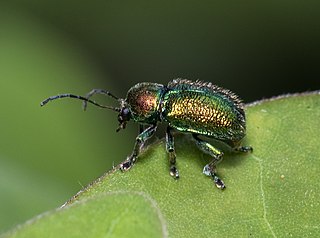
Colasposoma is a genus of leaf beetles in the subfamily Eumolpinae. It is known from Africa, Asia and Australia.

Platycorynus is a genus of leaf beetles in the subfamily Eumolpinae. Species of the genus are found in Africa and Asia.

Colaspoides is a genus of leaf beetles in the subfamily Eumolpinae. It is one of the largest genera in the subfamily, containing over 260 species worldwide. It is an extant genus but there is at least one species, C. eocenicus, found in Baltic amber from the Upper Eocene of Russia, and the genus has also been reported from the Miocene of the Dominican Republic.

Rhembastus is a genus of leaf beetles in the subfamily Eumolpinae, native to Africa. Whilst the taxonomy of the genus is disputed, the genus has been suggested as a biological control agent for Bryophyllum delagoense in Australia.

Pachnephorus is a genus of leaf beetles in the subfamily Eumolpinae. It is distributed in Africa, Asia and Europe.

Eumolpini is a tribe of leaf beetles in the subfamily Eumolpinae. It is the largest tribe in the subfamily, with approximately 170 genera found worldwide. Members of the tribe almost always have a longitudinal median groove on the pygidium, which possibly helps to keep the elytra locked at rest. They also generally have a subglabrous body, as well as appendiculate pretarsal claws.

Typophorini is a tribe of leaf beetles in the subfamily Eumolpinae. The tribe contains approximately 100 genera, which are found worldwide. Members of the tribe are mainly characterized by notches on the tibiae of the middle and hind legs, which are sometimes referred to as antenna cleaners. They also generally have a subglabrous body, as well as bifid pretarsal claws.

Euryope is a genus of leaf beetles in the subfamily Eumolpinae. It is distributed in Africa and the Arabian Peninsula.

Abirus is a genus of leaf beetles in the subfamily Eumolpinae. It is distributed from the Malay Archipelago to the Indian subcontinent, China, and the Ryukyu Islands. The genus was first established by the Belgian entomologist Félicien Chapuis in 1874, as a split of Dermorhytis.
Eryxia is a genus of leaf beetles in the subfamily Eumolpinae. It is distributed in Africa and Western Asia.

Microeurydemus is a genus of leaf beetles in the subfamily Eumolpinae. It is known from Africa and the Arabian Peninsula.
Pagria is a genus of leaf beetles in the subfamily Eumolpinae. It is known from Africa, Asia and Australia.
Pathius is a genus of leaf beetles in the subfamily Eumolpinae. It is known from Africa and the Arabian Peninsula.
Chrysolampra is a genus of leaf beetles in the subfamily Eumolpinae. It is distributed in Asia and Australia. It is very closely related to Colaspoides, and is possibly a subgenus of it according to L. N. Medvedev (2004).
Cleoporus is a genus of leaf beetles in the subfamily Eumolpinae. It is known from Asia.

Trichochrysea is a genus of leaf beetles in the subfamily Eumolpinae. It is distributed in Asia.

Euryopini is a tribe of leaf beetles in the subfamily Eumolpinae.

Bromiini is a tribe of leaf beetles in the subfamily Eumolpinae. The tribe contains approximately 120 genera, which are found worldwide. They are generally thought to be an artificial group, often with a subcylindrical prothorax without lateral ridges and covered with setae or scales.
Macrocoma henoni is a species of leaf beetle from North Africa and Iraq. It was first described by Maurice Pic in 1894, as a species of Pseudocolaspis.













